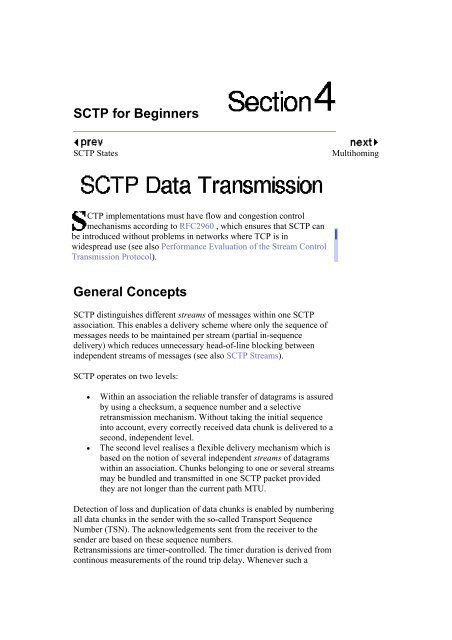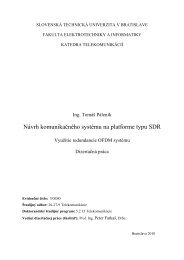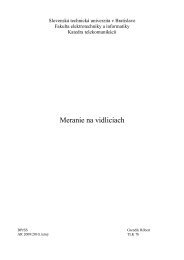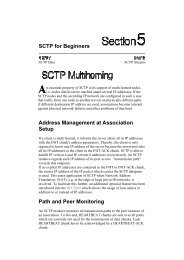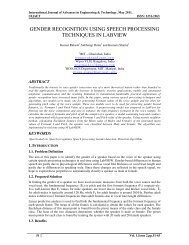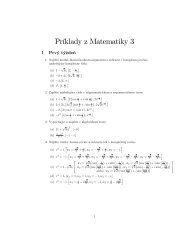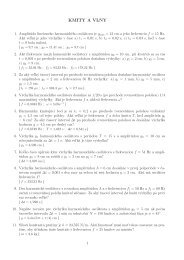04 SCTP for Beginners SCTP Data Transmission.pdf
04 SCTP for Beginners SCTP Data Transmission.pdf
04 SCTP for Beginners SCTP Data Transmission.pdf
- No tags were found...
You also want an ePaper? Increase the reach of your titles
YUMPU automatically turns print PDFs into web optimized ePapers that Google loves.
<strong>SCTP</strong> <strong>for</strong> <strong>Beginners</strong><strong>SCTP</strong> StatesMultihomingCTP implementations must have flow and congestion controlmechanisms according to RFC2960 , which ensures that <strong>SCTP</strong> canbe introduced without problems in networks where TCP is inwidespread use (see also Per<strong>for</strong>mance Evaluation of the Stream Control<strong>Transmission</strong> Protocol).General Concepts<strong>SCTP</strong> distinguishes different streams of messages within one <strong>SCTP</strong>association. This enables a delivery scheme where only the sequence ofmessages needs to be maintained per stream (partial in-sequencedelivery) which reduces unnecessary head-of-line blocking betweenindependent streams of messages (see also <strong>SCTP</strong> Streams).<strong>SCTP</strong> operates on two levels:• Within an association the reliable transfer of datagrams is assuredby using a checksum, a sequence number and a selectiveretransmission mechanism. Without taking the initial sequenceinto account, every correctly received data chunk is delivered to asecond, independent level.• The second level realises a flexible delivery mechanism which isbased on the notion of several independent streams of datagramswithin an association. Chunks belonging to one or several streamsmay be bundled and transmitted in one <strong>SCTP</strong> packet providedthey are not longer than the current path MTU.Detection of loss and duplication of data chunks is enabled by numberingall data chunks in the sender with the so-called Transport SequenceNumber (TSN). The acknowledgements sent from the receiver to thesender are based on these sequence numbers.Retransmissions are timer-controlled. The timer duration is derived fromcontinous measurements of the round trip delay. Whenever such a
etransmission timer expires, (and congestion control allowstransmissions) all non-acknowledged data chunks are retransmitted andthe timer is started again doubling its initial duration (like in TCP).When the receiver detects one or more gaps in the sequence of datachunks, each received <strong>SCTP</strong> packet is acknowleged by sending aSelective Acknowledgement (SACK) which reports all gaps. The SACKis contained in a specific control chunk. Whenever the sender receivesfour consecutive SACKs reporting the same data chunk missing, this datachunk is immediately retransmitted (fast retransmit). Most up-to-dateoperating systems already support a similar optional extension to TCP(see RFC 2018).Flow Control<strong>SCTP</strong> uses an end-to-end window based flow and congestion controlmechanism similar to the one that is well known from TCP (see RFC2581 - TCP Congestion Control). The receiver of data may control therate at which the sender is sending by specifying an octet-based windowsize (the so-called Receiver Window), and returning this value along withall SACK chunks.The sender itself keeps a variable known as Congestion Window (short:CWND) that controls the maximum number of outstanding bytes (i.e.bytes that may be sent be<strong>for</strong>e they are acknowledged). Each receveiveddata chunk must be acknlowlegded, and the receiver may wait a certaintime (usually 200 ms) be<strong>for</strong>e that is done. Should there be a largernumber of <strong>SCTP</strong> packets with data received within this period of, everysecond <strong>SCTP</strong> packet containing data is to be acknowlegded at once bysending a SACK chunk back to the sender.Selective AcknowledgementThe acknowledgements carry all TSN numbers that have been receivedby one side with them. That is, there is a so called Cumulative TSN Ackvalue, that inidicates all the data that has successfully been reassembledat the receivers side, and has either already been delivered to thereceiving Upper Layer Process, or may readily be delivered upon request.Moreover, there are so-called Gap Blocks that indicate that segments ofdata chunks have arrived, with some data chunks missing in between.Should some data chunks have been lost in the course of transmission,they will either be retransmitted after the transmission timer has expired,or after four SACK chunks have reported gaps with the same data chunkmissing. In the latter case, the missing data is retransmitted via the FastRetransmit mechanism.In case a retransmission occurrs which signals packet loss, theimplementation must appropriately update congestion and flow controlparameters.
Flow Control <strong>for</strong> Multihomed EndpointsBy default, all transmission is done to a previously selected address fromthe set of destination addresses, which is called the Primary Address.Retransmissions should be done on different paths, so that if one path isoverloaded, retransmissions do not affect this path (unless the networktopology is such that retransmissions hit the same point in the networkwhere the data was dropped due to congestion). For certain networktopologies that may have beneficial effects on overall throughput.Acknowledgements shall be sent to the transport address from whichoriginated the data.Should the active path have a high number of failures and its errorcounter exceed a boundary, the <strong>SCTP</strong> implementation notifies its upperlayer process that the path has become inactive. Then a new primary pathmay (and probably should) be chosen by the application (<strong>for</strong> morein<strong>for</strong>mation on this, see <strong>SCTP</strong> Multihoming).Congestion ControlThe congestion control behaviour of an <strong>SCTP</strong> implementation accordingto RFC2960 may have an impact where timely delivery of messages isrequired (i.e. transport of signalling data). However, this ensures theproper behaviour of <strong>SCTP</strong> when it is introduced on a large scale intoexisting packet switched networks such as the Internet. The congestioncontrol mechanismns <strong>for</strong> <strong>SCTP</strong> have been derived from RFC 2581 - TCPCongestion Control), and been adapted <strong>for</strong> multihoming. For eachdestination address (i.e. each possible path) a discrete set of flow andcongestion control parameters is kept, such that from the point of view ofthe network, an <strong>SCTP</strong> association with a number of paths may behavesimilarly as the same number of TCP connections.Slow Start and Congestion AvoidanceAs in TCP, <strong>SCTP</strong> has two modes, Slow Start and Congestion Avoidance.The mode is determined by a set of congestion control variables, and asalready mentioned, these are path specific. So, while the transmission tothe primary path may be in the Congestion Avoidance mode, theimplementation may still use Slow Start <strong>for</strong> the backup path(s).For successfully delivered and acknowledged data the congestionwindow variable (CWND) is steadily increased, and once it exceeds acertain boundary (called Slow Start Threshold, SSTRESH), the modechanges from Slow Start to Congestion Avoidance. Generally, in SlowStart, the CWND is increased faster (roughly one MTU per receivedSACK chunk), and in Congestion Avoidance mode, it is only increasedby roughly one MTU per Round Trip Time (RTT).Events that trigger retransmission (timeouts or fast retransmission) cause
the SSTHRESH to be cut down drastically, and reset the CWND (wherea timeout causes a new Slow Start with CWND=MTU, and a FastRetransmit sets CWND=SSTHRESH).Path MTU DiscoverySince the Path MTU is such an important variable (influencing thecongestion control), an <strong>SCTP</strong> implemetations should keep a variable <strong>for</strong>the estimate of the current Maximum <strong>Transmission</strong> Unit (Path MTU) <strong>for</strong>each path. How this is done, is closer described in RFC 1191 - Path MTUDiscovery and RFC 1981 - Path MTU Discovery <strong>for</strong> IP Version 6.


